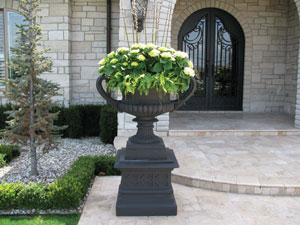11/15/2009
Potted Hydrangea How-Tos
Bob Ondejko

At Seacliff Greenhouses in Leamington, Ontario, we’ve been growing dormant and finished potted hydrangeas for more than 20 years. During those years, we’ve been committed to selecting and growing varieties that are suitable for production in sizes ranging from 4.5-in. to 14-in. pots.
Potted hydrangeas have typically been grown for Easter and Mother’s Day as a beautiful flowering indoor plant. These pot plants can then be planted outdoors and, depending on the region’s climate, can perform in the garden for years to come. However, because hydrangeas can be brought into flower almost year-round with quality dormant plants, there are so many more uses and opportunities for this versatile plant. For example, summer hydrangea production can allow consumers to enjoy hydrangeas in creative combinations containers or in planters by themselves.
Timing
For Easter production, total forcing time is 11 to 12 weeks, depending on variety and climate. For crops ready for Mother’s Day sales, forcing time is 9 to 10 weeks.
As a general rule, with an average temperature of 60F (16C), the flower size should be:
Eight weeks before sale date: pea size
Six weeks before sale date: nickel size
Four weeks before sale date: half-dollar size
Two weeks before sale date: starting to color
Suggested spacing requirements
4.5-in. pot: 11 in. x 11 in.
6.5-in. pot: 15 in. x 15 in.
10-in. pot: 24 in. x 24 in.
Hydrangea color and fertilization
Seven to 14 days after you put the potted dormant crop in the greenhouse, begin fertilizing at 100 to 150 ppm nitrogen to help activate roots and promote top growth. Continue with a 100 to 150 ppm nitrogen constant feed program, according to the color.
For pink, red and white colors, maintain a pH of 5.8 to 6.2 using a high-phosphate, low-potassium feed. For blue and mauve colors, maintain a pH of 5.0 to 5.5 using a low-phosphate, high-potassium feed.
To produce a strong blue color, you must monitor pH and keep it between 5.0 and 5.5, and also apply aluminum sulfate as needed. Two to four applications may be required.
Light
Light levels should be reduced to 300 to 350 watts per sq. m. when plants start to show color in order to maintain a rich and vibrant color in the finished plant. Shading may be required.
Water management
Never let your hydrangea plants wilt, as that will cause the plants to lose their lower leaves, thereby reducing overall quality. This is especially important in the later stages of production. Wilting may also cause bud or flower damage. Soil testing should also be done on a regular basis.
Growth regulators
Apply growth regulators as needed, with B-Nine being the preferred PGR for most growers. Apply at a rate of 500 to 2,500 ppm, depending on the variety and height. PGRs are generally applied in the middle of the growth cycle, from about four weeks in the greenhouse until just before the plants begin to show color.
Insects and diseases
Insect problems can include aphids and spider mites. Disease problems can include Botrytis and powdery mildew. Hydrangeas can be a sensitive crop—use caution with fungicides and insecticides.